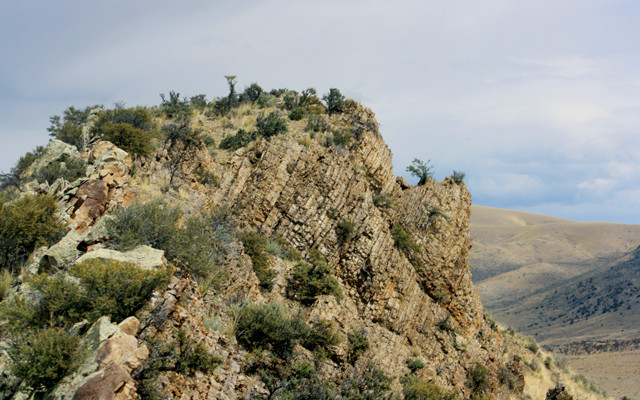
by Julia Rosen Monday, April 20, 2015

Phosphorite rocks in a number of U.S. localities were found to contain high levels of valuable rare earth elements. Credit: Ryan Shell, GFDL.
The modern world runs on rare earth metals — they are essential ingredients in light bulbs, smartphones, wind turbines and military weapons, among other uses. Currently, China supplies more than 95 percent of the global demand for rare earth elements (REEs), giving it a virtual monopoly. But new research suggests that the United States may contain vast domestic reserves of its own that could dwarf known deposits.
According to the research, published in the journal Gondwana Research, phosphorus-rich sedimentary rocks called phosphorites could meet much of the world’s growing demand and yield more REEs than the sources currently mined in China.
Researchers stumbled upon the discovery serendipitously, says Poul Emsbo, a research geologist with the U.S. Geological Survey (USGS) and lead author of the study. Emsbo originally set out to understand why certain mineral deposits formed on the ocean floor during some geologic eras, but not others. In the process, he and his colleagues found evidence for what looked like large changes in ocean chemistry over time, including variations in REE concentrations.
So they went looking for phosphorites on land, because these rocks also formed at the bottom of the ocean and their compositions are thought to be sensitive to the same chemical changes Emsbo detected in marine records. The team of scientists from the USGS and the Wisconsin Geological Survey focused on a particular variety of the mineral fluorapatite, called francolite, which constitutes the bulk of phosphorite rocks but also contains trace amounts of rare earth metals (the metals readily substitute for calcium in the mineral’s crystal structure).
The researchers gathered samples from 23 phosphorite formations around the U.S. that formed at different times in Earth’s history. In addition to confirming the chemical variations he saw in ocean sediments, Emsbo found something else: in phosphorite deposits of certain ages, the concentrations of rare earths greatly exceeded those in the major Chinese deposits. And these were not isolated anomalies either; multiple samples collected from distant locations within a single unit showed similar levels.
The phosphorites contain especially high amounts of heavy rare earths, defined in the study as the lanthanide elements europium through lutetium, plus yttrium. Demand for these heavy REEs has soared over the last decade or so, but they are more difficult to find in economically viable deposits than their lighter counterparts. Nearly all of the current supply comes from low-grade ion-adsorbing clays in Southern China.
Many of the phosphorite deposits identified in the new study are already being mined, but not for rare earths: These rocks are the primary source of the phosphorus fertilizer that drives modern agriculture. “The amount of rare earths going through fertilizer processing circuits from the phosphate industry is extraordinary,” Emsbo says. This waste could supply about 15 percent of the total global rare earth demand and 65 percent of the heavy rare earth demand every year, the team estimated, noting that much more could be extracted from currently unmined phosphorite deposits in Oklahoma, Arkansas, New York and elsewhere.
Phosphorites offer several potential advantages over some other kinds of rare earth deposits. Notably, REEs may be much easier to extract from phosphorites than they are from the complex minerals found in many igneous rocks; in laboratory experiments, Emsbo’s team found that nearly 100 percent of REEs went into solution when dissolved in sulfuric acid. They also tend to lack hazardous radioactive elements like uranium and thorium, which plague many REE-rich deposits.
So why had no one thought of this before? Actually, Emsbo says, the USGS had — in the 1960s — but nothing ever came of this early work. Perhaps that’s because many people assume that “all phosphates are created equal,” Emsbo says, causing researchers and exploration geologists to overlook these highly enriched formations. In addition, he says, the field has focused mostly on rare earth deposits produced by magmatic processes.
But there’s a good reason for that focus, says Anthony Mariano, an exploration geologist and consultant: These igneous deposits have been explored extensively through detailed mapping and sampling, and their rare earth potential has been demonstrated. Until the same can be said of phosphorite formations, he says, “there are a couple of igneous deposits in the U.S. that I feel are much more promising.” Frances Wall, a geologist at the University of Exeter, agrees that “larger, exploration-style” studies are necessary. “The results here are interesting, but do not establish that any of these deposits are potential rare earth mines,” she says.
For their part, phosphate producers know about the REE potential of their rocks, says Patrick Zhang, the mining and beneficiation research director at the Florida Industrial and Phosphate Research Institute. The main hurdle is recovering these elements; using current commercial processing methods, Zhang’s experiments show that only 30 percent of REEs end up in solution. The rest end up in the waste mineral, phosphogypsum. Eventually, these tailings could also be exploited, “but lots of process development work needs to be done,” Zhang says.
© 2008-2021. All rights reserved. Any copying, redistribution or retransmission of any of the contents of this service without the expressed written permission of the American Geosciences Institute is expressly prohibited. Click here for all copyright requests.